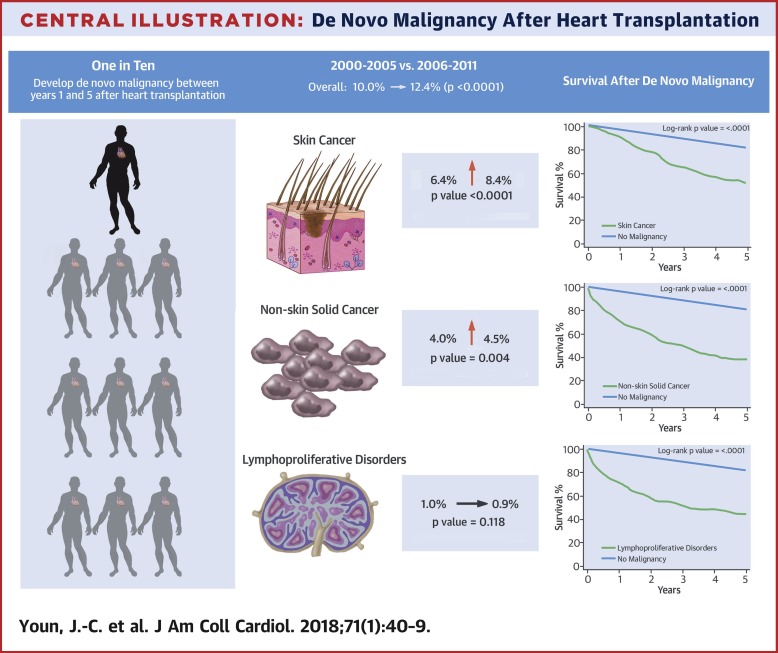当前位置:
X-MOL 学术
›
J. Am. Coll. Cardiol.
›
论文详情
Our official English website, www.x-mol.net, welcomes your feedback! (Note: you will need to create a separate account there.)
Temporal Trends of De Novo Malignancy Development After Heart Transplantation
Journal of the American College of Cardiology ( IF 24.0 ) Pub Date : 2018-01-01 , DOI: 10.1016/j.jacc.2017.10.077 Jong-Chan Youn , Josef Stehlik , Amber R. Wilk , Wida Cherikh , In-Cheol Kim , Gyeong-Hun Park , Lars H. Lund , Howard J. Eisen , Do Young Kim , Sun Ki Lee , Suk-Won Choi , Seongwoo Han , Kyu-Hyung Ryu , Seok-Min Kang , Jon A. Kobashigawa
Journal of the American College of Cardiology ( IF 24.0 ) Pub Date : 2018-01-01 , DOI: 10.1016/j.jacc.2017.10.077 Jong-Chan Youn , Josef Stehlik , Amber R. Wilk , Wida Cherikh , In-Cheol Kim , Gyeong-Hun Park , Lars H. Lund , Howard J. Eisen , Do Young Kim , Sun Ki Lee , Suk-Won Choi , Seongwoo Han , Kyu-Hyung Ryu , Seok-Min Kang , Jon A. Kobashigawa

|
BACKGROUND
Malignancy is a concern in cardiac transplant recipients, but the temporal trends of de novo malignancy development are unknown. OBJECTIVES
The goal of this study was to describe the temporal trends of the incidence, types, and predictors of de novo malignancy in cardiac transplant recipients. METHODS
The authors analyzed the temporal trends of post-transplant incidence, types, and predictors of malignancy using 17,587 primary adult heart-only transplant recipients from the International Society for Heart and Lung Transplantation registry. The main study outcomes included the incidence of, types of, and time to de novo malignancy. RESULTS
The risk of any de novo solid malignancy between years 1 and 5 after transplantation was 10.7%. The cumulative incidence by malignancy type was: skin cancer (7.0%), non-skin solid cancer (4.0%), and lymphoproliferative disorders (0.9%). There was no temporal difference in the time to development according to malignancy type. However, the cumulative incidence of de novo solid malignancy increased from 2000 to 2005 vs. 2006 to 2011 (10.0% vs. 12.4%; p < 0.0001). Survival in patients after de novo malignancy was markedly lower than in patients without malignancy (p < 0.0001). Older recipients and patients who underwent transplantation in the recent era had a higher risk of de novo malignancy. CONCLUSIONS
More than 10% of adult heart transplant recipients developed de novo malignancy between years 1 and 5 after transplantation, and this outcome was associated with increased mortality. The incidence of post-transplant de novo solid malignancy increased temporally, with the largest increase in skin cancer. Individualized immunosuppression strategies and enhanced cancer screening should be studied to determine whether they can reduce the adverse outcomes of post-transplantation malignancy.
中文翻译:

心脏移植后新发恶性肿瘤发展的时间趋势
背景恶性肿瘤是心脏移植受者的一个问题,但新发恶性肿瘤发展的时间趋势尚不清楚。目的 本研究的目的是描述心脏移植受者新发恶性肿瘤的发生率、类型和预测因素的时间趋势。方法作者使用来自国际心肺移植协会登记处的 17,587 名主要成人仅心脏移植受者分析了移植后发病率、类型和恶性肿瘤预测因子的时间趋势。主要研究结果包括新发恶性肿瘤的发生率、类型和时间。结果 移植后第 1 年和第 5 年之间任何新发实体恶性肿瘤的风险为 10.7%。按恶性肿瘤类型的累积发病率为:皮肤癌(7.0%)、非皮肤实体癌(4.0%)、和淋巴组织增生性疾病(0.9%)。根据恶性肿瘤类型,发展时间没有时间差异。然而,从 2000 年到 2005 年与 2006 年到 2011 年相比,新发实体恶性肿瘤的累积发病率有所增加(10.0% 对 12.4%;p < 0.0001)。新发恶性肿瘤患者的存活率明显低于非恶性肿瘤患者(p < 0.0001)。年长的受者和最近接受移植的患者患新发恶性肿瘤的风险更高。结论 超过 10% 的成年心脏移植受者在移植后第 1 年和第 5 年之间发生了新发恶性肿瘤,而这一结果与死亡率增加有关。移植后新发实体恶性肿瘤的发病率暂时增加,其中皮肤癌的增加幅度最大。
更新日期:2018-01-01
中文翻译:

心脏移植后新发恶性肿瘤发展的时间趋势
背景恶性肿瘤是心脏移植受者的一个问题,但新发恶性肿瘤发展的时间趋势尚不清楚。目的 本研究的目的是描述心脏移植受者新发恶性肿瘤的发生率、类型和预测因素的时间趋势。方法作者使用来自国际心肺移植协会登记处的 17,587 名主要成人仅心脏移植受者分析了移植后发病率、类型和恶性肿瘤预测因子的时间趋势。主要研究结果包括新发恶性肿瘤的发生率、类型和时间。结果 移植后第 1 年和第 5 年之间任何新发实体恶性肿瘤的风险为 10.7%。按恶性肿瘤类型的累积发病率为:皮肤癌(7.0%)、非皮肤实体癌(4.0%)、和淋巴组织增生性疾病(0.9%)。根据恶性肿瘤类型,发展时间没有时间差异。然而,从 2000 年到 2005 年与 2006 年到 2011 年相比,新发实体恶性肿瘤的累积发病率有所增加(10.0% 对 12.4%;p < 0.0001)。新发恶性肿瘤患者的存活率明显低于非恶性肿瘤患者(p < 0.0001)。年长的受者和最近接受移植的患者患新发恶性肿瘤的风险更高。结论 超过 10% 的成年心脏移植受者在移植后第 1 年和第 5 年之间发生了新发恶性肿瘤,而这一结果与死亡率增加有关。移植后新发实体恶性肿瘤的发病率暂时增加,其中皮肤癌的增加幅度最大。


























 京公网安备 11010802027423号
京公网安备 11010802027423号